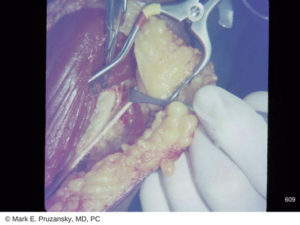Radial Tunnel Syndrome

Decompression of radial nerve at the elbow at the Arcade of Frohse.
What is Radial Tunnel Syndrome
The radial nerve is one of the major nerves of the arm that supplies the muscles of the forearm and hand with feeling.
Radial tunnel syndrome is characterized by a group of symptoms that are manifested as a result of compression of the radial nerve. The radial nerve passes between the muscles and bones of the forearm.
The radial nerve is present within radial tunnel in the forearm, which is prone to compression as it can face pressure from any of the surrounding structures due to previous injuries, accidents, genetic conditions, or sudden swelling.
Signs and Symptoms of Radial Tunnel Syndrome
Radial tunnel syndrome symptoms may suddenly strike a patient after an accident, such as if someone pushes or pulls something too hard. Overuse is a common trigger of radial tunnel syndrome as well, with many patients reporting discomfort stemming from repetitive movements of their hands and arms.
- Piercing, incising or stabbing pain in the forearm
- Piercing, incising or stabbing pain in the back of the hand
- Weakness of the hand and forearm
- Numbness is experienced rarely
- Tingling sensation is also faced at times
An important sign of radial tunnel syndrome is when a patient experiences sudden pain after trying to straighten their wrist or fingers.
Causes of Radial Tunnel Syndrome
As described earlier, radial tunnel syndrome occurs as a result of the compression or irritation of the radial nerve. There can be many factors that can lead to this compression or irritation.
In some cases, trauma or injuries involving the forearm can compress the radial nerve as a facet of the injury. Tumors, which may be benign or malignant, can also cause compression of the nerve.
If a patient experiences sudden swelling in their arm, due to an injury or allergic reaction, for example, they may also experience radial tunnel syndrome as their radial nerve is compressed.
Forceful and repetitive movements may also cause radial tunnel syndrome to develop as the area surrounding the nerve can become irritated and inflamed.
Getting a Diagnosis for Radial Tunnel Syndrome
Dr. Mark Pruzansky and Dr. Jason Pruzansky often see patients with radial tunnel syndrome and aim to use the least invasive methods of treatment in order to maximize mobility and comfort following an injury.
Radial tunnel syndrome can be diagnosed by taking a detailed history and performing a physical examination. Signs like sudden pain on straightening the wrist and hand can be important for diagnosis.
If the cause of a patient’s radial tunnel syndrome is unclear, there are additional tests can be performed. These include using an x-ray, which can be done in-office, or an electromyography. The latter test, however, is uncommonly performed.
Treatment of Radial Tunnel Syndrome
Dr. Mark Pruzansky and Dr. Jason Pruzansky prioritize conservative treatments whenever possible. In order to avoid surgery if the injury allows, some treatment options may include:
- Avoiding repetitive movements of the hand and wrist
- A splint to position the nerve properly
- Icing and hot compresses to avoid pain
- Physiotherapy
Some anti-inflammatory medicines and painkillers can also be given. In cases of severe inflammation, steroidal drugs may be prescribed to reduce the risk of further compression of the radial nerve.
Surgery may be required when symptoms persist after conservative management, or if the injury is too severe.
If You Believe You Have Radial Tunnel Syndrome, Contact HandSport Surgery Institute
Please contact us as soon as possible to schedule an appointment with our talented team. People experiencing radial tunnel syndrome should be evaluated to try and minimize the risks for further injury and mobility issues.
If you have been injured, it’s important to be evaluated by a highly skilled professional. Call Dr. Mark Pruzansky and Dr. Jason Pruzansky at 212-249-8700 to schedule an appointment and obtain an accurate diagnosis.



